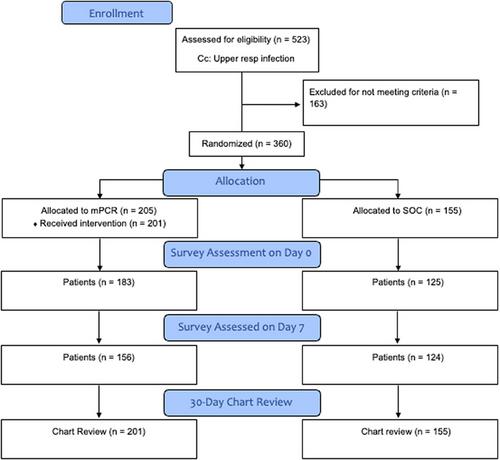A multicenter randomized control trial: Point-of-care syndromic assessment versus standard testing in urgent care center patients with acute respiratory illness
Abstract
Objective
Syndromic assessment with multiplex polymerase chain reaction (mPCR) testing in patients with acute respiratory illness (ARI) allows for simultaneous identification of multiple possible infectious etiologies. Point-of-care (POC) syndromic assessment can be conducted in a clinical setting, such as an urgent care center (UCC), without requiring certified laboratories. The primary objective of this study was to determine whether POC syndromic assessment improved patient satisfaction for patients seen at an UCC with ARI; secondary objectives included whether syndromic assessment reduced self-isolation time, increased diagnostic confidence, and reduced overall antibiotic utilization.
Methods
We conducted an unblinded multicenter randomized controlled trial on UCC patients with an ARI. Patients were randomized to either SC (defined as standard UCC testing for ARI) or syndromic assessment with POC mPCR. Patients were surveyed for patient satisfaction, self-isolation plans, diagnostic confidence, and overall antibiotic utilization.
Results
Among the 360 patients enrolled, those in the syndromic assessment group were more satisfied with the time required to communicate the results (98.4% vs. 42.4%, p < 0.001) on day of treatment, more likely to resume normal activities sooner (83.3% vs. 69.4%, p = 0.039), and more confident in their illness cause (60.7% vs. 29.6%, p < 0.001); however, the rate of antibiotic utilization did not differ (33.5% vs. 26%, p = 1.0).
Conclusion
In conclusion, our study provides evidence supporting the use of syndromic assessment in UCCs for ARI diagnosis, including patient-centered outcomes such as greater confidence in diagnosis and more efficient isolation strategies. This study did not show a difference in more clinically oriented outcomes, such as a change in antibiotic utilization. Future studies should identify clinical care pathways to improve antibiotic stewardship for likely viral syndromes and whether the increased initial cost of syndromic assessment is offset by the clinical benefits and subsequent cost savings.


 求助内容:
求助内容: 应助结果提醒方式:
应助结果提醒方式:


